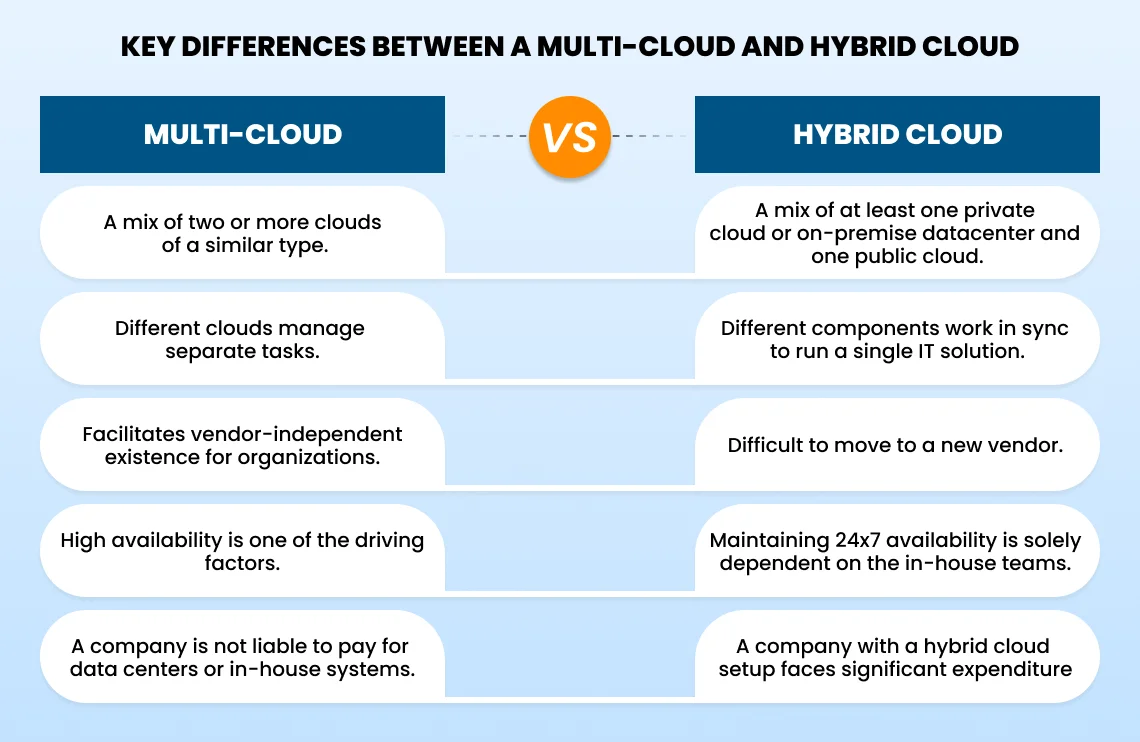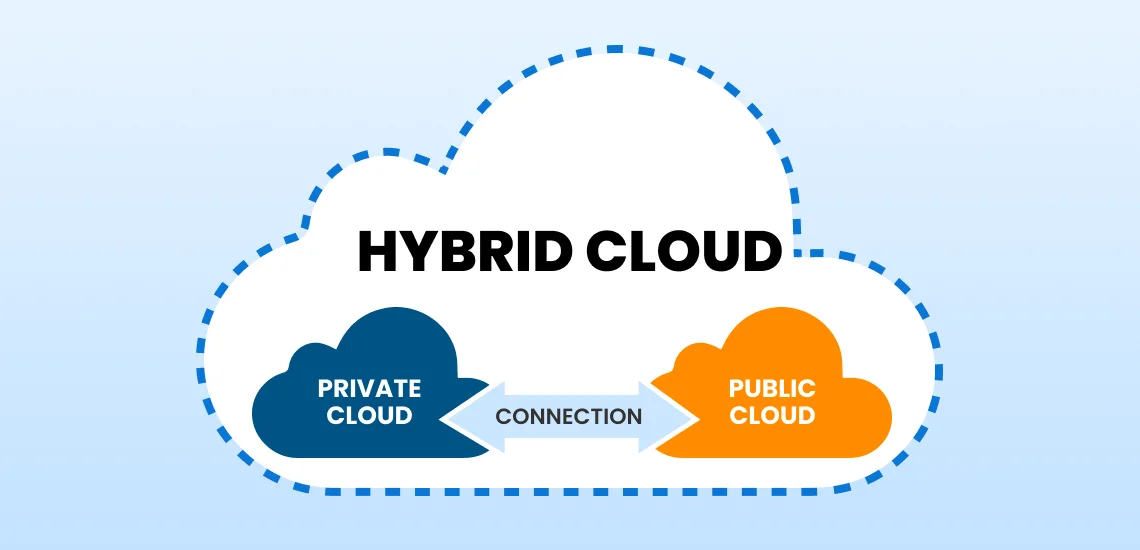Multi-Cloud vs Hybrid Cloud: Which is Right for Your Enterprise?
- DevOps
- March 4, 2024
Planning to switch your IT infrastructure to a cloud ecosystem or build your cloud-powered app? Then, it’s obvious to have an analytical debate on which one is right for your infrastructure in Multi cloud vs Hybrid cloud. This blog dives deep into the concepts of hybrid cloud and multi cloud and covers all the factors you should consider when choosing your cloud ecosystem.
Suppose a large e-commerce company decides to adopt a multi-cloud strategy. Its online platform experiences heavy traffic spikes during holiday seasons, and they want to ensure high availability, scalability, and performance for their customers worldwide.
It decides to utilize multiple cloud providers to distribute their workload efficiently. They choose Amazon Web Services (AWS), Microsoft Azure, and Google Cloud Platform (GCP) for their multi cloud architecture.
Contrary to it, let’s say you have a store where you sell handmade crafts. You keep your inventory records and customer information on your own computer in the store. In the holiday season, you use cloud service to handle the extra website traffic and orders. You just need another cloud to balance storage and fulfill resource requirements.
Multi cloud vs hybrid cloud, which is more useful, has been a long debate, and experts have different opinions about both types. In this blog, we will give you the desired insights and much-needed answers. So, you can decide which one to choose to run your ventures.
What is Cloud Computing?
Cloud computing allows users to access and use computing resources, including storage, servers, databases, networking, software, and applications through the internet using a pay-as-you-go pricing model.

In these solutions, service providers host and manage computing resources in data centers distributed across various geographic locations. Users can use them remotely with the internet without any on-site hardware setup or infrastructure. There are different types of cloud computing to fulfill diverse needs.
What’s the Difference Between Hybrid Cloud and Multi Cloud?
Hybrid cloud and multi cloud are two distinct approaches to cloud computing architecture, each has its unique advantages and serves different organizational needs. A hybrid cloud is a mix of private and public cloud environments that allow organizations to leverage the scalability and cost-effectiveness of the public cloud while retaining control over sensitive data and critical applications in private or on-premises environments.

Orchestration and integration tools are used to make the integration seamless and streamline data sharing and application deployment across the hybrid infrastructure. Organizations look after regulatory compliance requirements of hybrid cloud architectures or those with legacy systems that are hard to migrate to the public cloud.
Contrary to it, multi cloud strategies involve leveraging systems from multiple cloud providers such as Amazon Web Services (AWS), Microsoft Azure, and Google Cloud Platform (GCP). With multi cloud, organizations can avoid vendor lock-in, increase redundancy, and capitalize on unique strengths of different providers for specific workloads or applications.
In multi cloud setups, you can select different providers based on many factors like geographic regions, compliance needs, cost optimization, or technical capabilities. Its management demands robust orchestration, governance, and monitoring to ensure consistency, security, and efficient resource utilization across all the cloud platforms in use.
Also read: IaaS vs PaaS vs SaaS: Picking the Best Cloud Computing Service Model
Can Hybrid Cloud Function as Multi Cloud?
Yes, it is possible for hybrid cloud architecture to work as a multi cloud setup, providing the benefits of both integration and multi-provider flexibility. In the hybrid cloud environment, organizations can incorporate services from multiple cloud providers alongside their private infrastructure.

They can use the strengths of different cloud platforms while maintaining control over critical data and applications. By incorporating public cloud services from various providers into their hybrid infrastructure, organizations can achieve a multi-cloud setup, enabling them to avoid vendor lock-in, increase redundancy, and optimize costs.
Private cloud networks can also be part of a multi or hybrid cloud infrastructure. With careful orchestration and management, a hybrid cloud can seamlessly incorporate services from providers like AWS, Azure, and GCP, offering organizations the flexibility to select the most suitable cloud services for different workloads or requirements.
Therefore, while hybrid cloud architectures primarily focus on integrating public and private clouds, they can also serve as a foundation for a multi cloud strategy, providing organizations with a powerful combination of integration and flexibility in their cloud deployments.

Multi Cloud vs Hybrid Cloud: Which is More Advanced?
Multi cloud vs hybrid cloud is a vast topic to discuss as the choice is subjective and depends on many factors related to an organization’s needs. However, below-listed are some of the important aspects you can consider while making the final decision.
Infrastructure Composition
Cloud providers like AWS, Azure, GCP, etc., offer resources and services to multi-cloud architectures.
Cloud computing statistics show that 95% of enterprises are embracing a multi-cloud strategy, which highlights the growing trend.
Its infrastructure composition is decentralized and diverse and contains distributed resources across various cloud environments independently managed by different providers. These architectures offer redundancy resilience and let individuals combine best-of-breed services from different providers for specific use cases or requirements.
Hybrid clouds take the support of public and private cloud providers and on-premise infrastructure. Typically, hybrid cloud setups involve integrating public cloud services with existing on-premises data centers or private cloud environments, creating a unified infrastructure platform.
The infrastructure composition in a hybrid cloud environment is characterized by a blend of public cloud resources (like virtual machines, storage, and services) and private cloud resources (such as dedicated servers, storage arrays, and networking equipment). The architectures often incorporate orchestration and management tools to facilitate seamless integration and workload mobility between public and private clouds.
Data Management
Multi cloud environments involve the distribution of data across multiple cloud platforms from different providers. Data management in a multi-cloud setup requires careful consideration of data movement, synchronization, and interoperability between various cloud services.
You may face challenges related to data consistency, security, and compliance across disparate cloud environments. Organizations need robust data governance frameworks and management tools to track data across multiple clouds, enforce policies, and maintain visibility and control over data usage and access.
On the other hand, hybrid cloud architectures involve data management integrations between public cloud services and on-premises infrastructure. It addresses data integration complexities, migration, and synchronization issues between public and private clouds.
However, while managing hybrid environments, organizations must consider important aspects, such as data latency, bandwidth constraints, and regulatory compliance. Hybrid cloud setups often leverage data replication, backup, and disaster recovery solutions to ensure data availability and resilience across both cloud and on-premises environments.
Data management in a hybrid cloud typically involves integrating data management tools and practices between public cloud providers and private infrastructure, ensuring seamless data workflows and consistent governance.
Flexibility and Scalability
Multi cloud architecture enables organizations to leverage services from multiple cloud providers. They can pick the best services and features from different providers according to their specific needs, workload requirements, pricing, and geographical locations. With a multi-cloud approach, organizations can avoid vendor lock-in and have more control over their cloud environments.
Along with it, they can distribute workloads across multiple cloud platforms. It enables them to scale resources up or down based on demand by leveraging the elasticity and scalability features of different cloud providers. Organizations can also avoid resource constraints by using multiple cloud providers simultaneously, ensuring high availability and performance for their applications.
Hybrid cloud architecture combines on-premises infrastructure with cloud resources. It allows organizations to keep sensitive data and critical workloads on-premises while leveraging the scalability and cost-effectiveness of public cloud services for other workloads.
A hybrid cloud allows for workload mobility between on-premises and cloud environments, providing flexibility in deploying and managing applications. Along with it, its architecture allows organizations to dynamically scale their workloads between on-premises infrastructure and public cloud resources.
They handle fluctuations in workload demands more effectively by seamlessly scaling resources both on-premises and in the cloud as needed. Moreover, hybrid cloud environments can leverage burstable resources from public clouds during peak demand periods while keeping baseline workloads running on-premises, providing cost-effective scalability options.
Advantages of Multi Cloud
It avails diversification across multiple cloud providers and mitigates risks associated with outages or service disruptions from a single provider. In the event of a failure with one provider, services can be quickly shifted to another provider to maintain continuity.
Multi-cloud strategies allow organizations to take advantage of pricing variations among different cloud providers, optimizing costs by selecting the most cost-effective services for their specific workloads.
Multi cloud architectures enable organizations to comply with regulatory requirements by storing data in specific geographical regions or ensuring data sovereignty, as different cloud providers may offer data centers in different locations.
Advantages of Hybrid Cloud
A hybrid cloud allows organizations to maintain sensitive data on-premises, addressing compliance requirements or data sovereignty concerns that may restrict data storage or processing in public clouds.
Organizations can implement robust disaster recovery and business continuity strategies by replicating critical data and workloads between on-premises and cloud environments, ensuring resilience against disasters or outages.
It facilitates the integration of legacy systems with modern cloud services, allowing organizations to modernize their infrastructure gradually without disrupting existing operations.
Challenges of Multi Cloud
Multiple cloud environment management from different providers introduce complexity in terms of networking, security, governance, and operational management.
Establishing interoperability and compatibility between services taken from different providers can be a daunting task. Organizations may face issues related to data portability, integration, and consistency across different cloud environments.
Organizations need to address concerns related to data protection, identity management, access control, and regulatory requirements in each cloud platform.
Despite aiming to avoid vendor lock-in, organizations may inadvertently become dependent on specific cloud services or features from different providers, making it difficult to switch or migrate workloads in the future.
Challenges of Hybrid Cloud
It could be hard to integrate on-premises infrastructure with cloud environments. Organizations may face challenges related to connectivity, data synchronization, and application interoperability between hybrid components.
Issues like data movement, synchronization, and lack of consistency between on-premises and cloud-based storage systems might arise during the process.
Hybrid cloud architectures may suffer from network latency issues, especially while transferring data between on-premises and cloud environments.
Also read: Web App vs Cloud App – What Are The Differences and Benefits?
When to Choose Hybrid Cloud?
- If your organization deals with sensitive data that must remain on-premises due to regulatory compliance or security concerns
- If your organization has legacy systems or applications that cannot be easily migrated to the cloud but require interaction with cloud-based solutions
- If your company is experiencing fluctuating workloads or seasonal demands
- If you need to maintain high availability and resilience and optimize costs without compromising performance
When to Choose Multi Cloud?
- If your organization prioritizes vendor diversity and wants to avoid vendor lock-in
- When your organization requires specific features, capabilities, or pricing models offered by different cloud providers
- If your organization operates globally and requires infrastructure deployed in multiple regions or countries
- When your organization has specialized workloads or applications that require specific cloud services
- If regulatory compliance requires data to be stored or processed in specific geographic locations or with certain providers
In a nutshell, there is no winner in the multi cloud vs hybrid cloud battle. The decision depends on the specific needs, objectives, and constraints of each organization. Both approaches offer distinct advantages and challenges, and there is no one-size-fits-all solution. To make the right choice, you can connect with a reliable digital transformation company providing cloud solutions.

Why Choose MindInventory to Avail Cloud Solutions?
MindInventory propels your business growth forward with meticulously crafted customized cloud computing solutions. From seamless migration and architecture design to deployment and ongoing optimization, we provide end-to-end cloud services that guarantee scalability, flexibility, and unbeatable performance.
At MindInventory, we pride ourselves on our customer-centric approach, prioritizing communication, collaboration, and transparency every step of the way. With us as your trusted technology partner, innovation is not just a buzzword – it’s the driving force behind every solution we deliver.
FAQs on Hybrid Cloud and Multi Cloud
Enterprise Hybrid Cloud refers to a computing environment that combines elements of both private and public clouds to meet the specific needs of large organizations. In this model, critical workloads and sensitive data are hosted on-premises within a private cloud infrastructure, providing enhanced security, control, and compliance.
Organizations opt for hybrid and multi cloud approaches to leverage the unique advantages offered by each model. Hybrid cloud combines the security and control of on-premises infrastructure with the scalability and flexibility. Multi cloud enables organizations to avoid vendor lock-in and leverage best-of-breed services from multiple cloud providers.
Multi-tenant cloud computing refers to a model where a single cloud infrastructure serves multiple users or “tenants” who share the same computing resources, such as servers, storage, and networking infrastructure.













